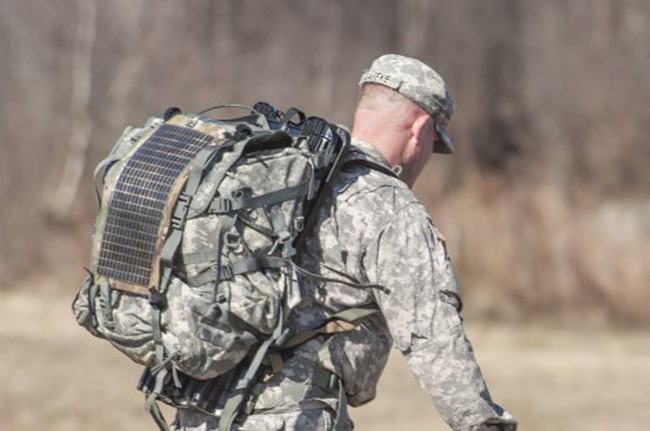
By Jeff Sisto, NSRDEC Public Affairs
Wearable technologies may provide U.S. Soldiers with on-the-move, portable energy and reduce the weight of gear they carry into combat.
Researchers at the Natick Soldier Research, Development and Engineering Center, or NSRDEC, are developing Soldier-borne energy-harvesting technologies.
During the Maneuver Fires Integration Experiment, or MFIX, a combined, multi-phase joint training exercise held in September 2014, at Fort Benning, Georgia, researchers tested prototype energy-harvesting technology solutions.
“My initial impression is that they fulfill a need for instant power generation on long-range missions when displaced from traditional resupply methods,” said Sgt. 1st Class Arthur H. Jones, an infantryman with the Maneuver Center of Excellence who participated in the demonstration.
A sharp rise in Soldier-worn power capabilities has resulted in a dramatic increase in the number, variety and weight of batteries carried by warfighters in the field.
This weight prompted NSRDEC researchers to begin developing and evaluating small, lightweight, efficient, on-the-move, portable energy-harvesting and distribution systems that eliminate the need to carry extra batteries.
Energy harvesting works by capturing small amounts of energy that would otherwise be lost as heat, light, sound, vibration or movement. It uses that energy to recharge batteries and provide power for electronic devices such as a Soldier’s communication equipment, sensors, or battlefield situational displays.
Researchers first demonstrated the concept to Army and government representatives at Fort Devens, Massachusetts, in April 2014. The demonstration consisted of experienced Soldiers wearing three energy-harvesting devices while traversing a four-mile course that included hard surfaced roads, lightly wooded areas, open fields and hilly terrain.
The technologies, which included wearable solar panels, backpack and knee kinetic energy-harvesting devices, are now being tested at MFIX as ways to reduce the weight and number of batteries Soldiers must carry to power electronic devices.
Lightning Pack’s Rucksack Harvester relies on the weight of the backpack to produce kinetic energy when the backpack oscillates vertically in response to the Soldier’s walking or running stride. As the backpack is displaced vertically, a rack attached to the frame spins a pinion that, in turn, is attached to a miniature power generator. It is capable of producing 16 to 22 watts while walking, and 22 to 40 watts while running.
Bionic Power’s Knee Harvester collects kinetic energy by recovering the power generated when walking. The articulating device is attached to both the upper and lower part of each leg and extracts energy when the knee is flexed. Through software control, the knee harvester analyzes the wearer’s gait and harvests energy during the phase of the stride when negative work is being performed. This attests that the Soldier is exhibiting less metabolic activity descending when compared with descending without wearing the device.
MC-10’s photovoltaic, or PV, Solar Panel Harvester operates by converting sunlight into electrical energy. The panels, which cover a Soldier’s backpack and helmet, are constructed from thin gallium arsenide crystals that provide flexibility to the panel’s material and allow it to conform to a Soldier’s gear. Under bright sunlight conditions, with the PV panel facing the sun, the backpack panel is capable of delivering 10 watts while the helmet cover panels provide seven watts of electrical power.
At MFIX, NSRDEC researchers collected power-management data and assessed user feedback from the Soldiers wearing the technologies. Once the energy-harvesting technologies themselves are validated, the next step will be to sync with the Integrated Soldier Power Data System as a way to distribute the energy to a Soldier’s electronic devices.




